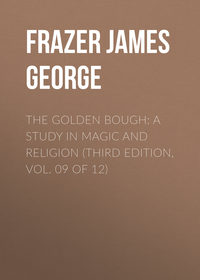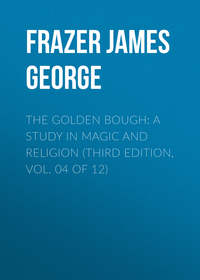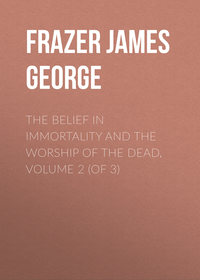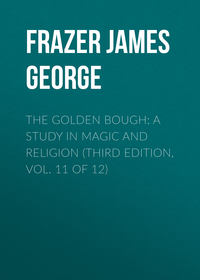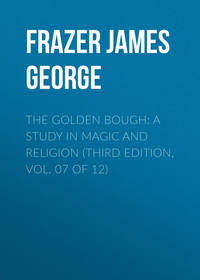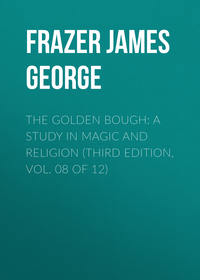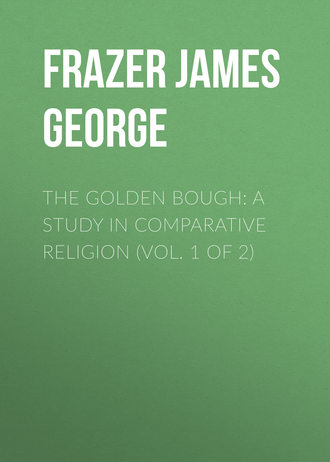
The Golden Bough: A Study in Comparative Religion (Vol. 1 of 2)
985
Op. cit. 27, § 1.
986
Isis et Osiris, 21, αινῶ δὲ τομὴν ξύλου καὶ σχίσιν λίνου καὶ χοὰς χεομένας. διὰ τὸ πολλὰ τῶν μυστικῶν ἀναμεμῖχθαι τούτοις. Again, c. 42, τὸ δὲ ξύλον ἐν ταῖς λεγομέναις; Ὀσίριδος ταφαῖς τέμνοντες κατασκευάζουσι λάρνακα μηνοειδὴ.
987
See above, p. 304.
988
Lefébure, Le mythe Osirien, pp. 194, 198, referring to Mariette, Denderah, iv. 66 and 72.
989
Lefébure, op. cit. pp. 195, 197.
990
Birch, in Wilkinson's Manners and Customs of the Ancient Egyptians (London, 1878), iii. 84.
991
Wilkinson, op. cit. iii. 63 sq.; Ed. Meyer, Geschichte des Alterthums, i. §§ 56, 60.
992
Wilkinson, op. cit. iii. 349 sq.; Brugsch, Religion und Mythologie der alten Aegypter, p. 621; Plutarch, Isis et Osiris, 20. In Plutarch l. c. Parthey proposes to read μυρίκης for μηθίδης, and this conjecture appears to be accepted by Wilkinson, l. c.
993
Lefébure, Le mythe Osirien, p. 191.
994
Lefébure, op. cit. p. 188.
995
Plutarch, Isis et Osiris, 35. One of the points in which the myths of Isis and Demeter agree, is that both goddesses in their search for the loved and lost one are said to have sat down, sad at heart and weary, on the edge of a well. Hence those who had been initiated at Eleusis were forbidden to sit on a well. Plutarch, Isis et Osiris, 15; Homer, Hymn to Demeter, 98 sq.; Pausanias, i. 39, 1; Apollodorus, i. 5, 1; Nicander, Theriaca, 486; Clemens Alex., Protrept. ii. 20.
996
Brugsch, Religion und Mythologie der alten Aegypter, p. 645.
997
C. P. Tiele, History of Egyptian Religion, p. 57.
998
Hibbert Lectures, 1879, p. 111.
999
Diodorus, i. 14. Eusebius (Praeparat. Evang. iii. 3) quotes from Diodorus (i. 11-13) a long passage on the early religion of Egypt, prefacing the quotation (c. 2) with the remark γράφει δὲ καὶ τὰ περὶ τούτων πλατύτερον μὲν ὁ Μανέθως, ἐπετετμημένως δὲ ὁ Διόδωρος, which seems to imply that Diodorus epitomised Manetho.
1000
Brugsch, op. cit. p. 647.
1001
Brugsch, op. cit. p. 649.
1002
Brugsch,l. c.
1003
Herodotus, ii. 59, 156; Diodorus, i. 13, 25, 96; Apollodorus, ii. 1, 3; Tzetzes, Schol. in Lycophron. 212.
1004
Antholog. Planud. 264, 1.
1005
Orphica, ed. Abel, p. 295 sqq.
1006
Jablonski, Pantheon Aegyptiorum (Frankfurt, 1750), i. 125 sq.
1007
i. 11.
1008
See p. 310, note.
1009
See the Saturnalia, bk. i.
1010
Saturn. i. 21, 11.
1011
Maspero, Histoire ancienne des peuples de l'Orient4 (Paris, 1886), p. 35.
1012
Wilkinson, Manners and Customs of the Ancient Egyptians (London, 1878), iii. 353.
1013
Isis et Osiris, 52.
1014
De errore profan. religionum, 8.
1015
Lepsius, “Ueber den ersten aegyptischen Götterkreis und seine geschichtlich-mythologische Entstehung,” in Abhandlungen der königlichen Akademie der Wissenschaften zu Berlin, 1851, p. 194 sq.
1016
The view here taken of the history of Egyptian religion is based on the sketch in Erman's Aegypten und aegyptisches Leben im Altertum, p. 351 sqq.
1017
On this attempted revolution in religion see Lepsius in Verhandl. d. königl. Akad. d. Wissensch. zu Berlin, 1851, pp. 196-201; Erman, op. cit. p. 355 sqq.
1018
Tiele, History of the Egyptian Religion, p. 44.
1019
Tiele, op. cit. p. 46.
1020
Ib. p. 45.
1021
Le Page Renouf, Hibbert Lectures, 1879, p. 111 sqq.
1022
Hibbert Lectures, 1879, p. 113. Cp. Maspero, Histoire ancienne,4 p. 35; Ed. Meyer, Geschichte des Alterthums, i. §§ 55, 57.
1023
There are far more plausible grounds for identifying Osiris with the moon than with the sun – 1. He was said to have lived or reigned twenty-eight years; Plutarch, Isis et Osiris, cc. 13, 42. This might be taken as a mythical expression for a lunar month. 2. His body was rent into fourteen pieces (ib. cc. 18, 42). This might be interpreted of the moon on the wane, losing a piece of itself on each of the fourteen days which make up the second half of a lunation. It is expressly mentioned that Typhon found the body of Osiris at the full moon (ib. 8); thus the dismemberment of the god would begin with the waning of the moon. 3. In a hymn supposed to be addressed by Isis to Osiris, it is said that Thoth
“Placeth thy soul in the bark Ma-at,In that name which is thine, of God Moon.”
And again,
“Thou who comest to us as a child each month,We do not cease to contemplate thee,Thine emanation heightens the brilliancyOf the stars of Orion in the firmament,” etc.
Records of the Past, i. 121 sq.; Brugsch, Religion und Mythologie der alten Aegypter, p. 629 sq. Here then Osiris is identified with the moon in set terms. If in the same hymn he is said to “illuminate us like Ra” (the sun), this, as we have already seen, is no reason for identifying him with the sun, but quite the contrary. 4. At the new moon of the month Phanemoth, being the beginning of spring, the Egyptians celebrated what they called “the entry of Osiris into the moon.” Plutarch, Is. et Os. 43. 5. The bull Apis, which was regarded as an image of the soul of Osiris (Is. et Os. cc. 20, 29), was born of a cow which was believed to have been impregnated by the moon (ib. 43). 6. Once a year, at the full moon, pigs were sacrificed simultaneously to the moon and Osiris. Herodotus, ii. 47; Plutarch, Is. et Os. 8. The relation of the pig to Osiris will be examined later on.
Without attempting to explain in detail why a god of vegetation, as I take Osiris to have been, should have been brought into such close connection with the moon, I may refer to the intimate relation which is vulgarly believed to subsist between the growth of vegetation and the phases of the moon. See e. g. Pliny, Nat. Hist. ii. 221, xvi. 190, xvii. 108, 215, xviii. 200, 228, 308, 314; Plutarch, Quaest. Conviv. iii. 10, 3; Aulus Gellius, xx. 8, 7; Macrobius, Saturn. vii. 16, 29 sq. Many examples are furnished by the ancient writers on agriculture, e. g. Cato, 37, 4; Varro, i. 37; Geoponica, i. 6.
1024
Herodotus, ii. 42, 49, 59, 144, 156; Plutarch, Isis et Osiris, 13, 35; id., Quaest. Conviv. iv. 5, 3; Diodorus, i. 13, 25, 96, iv. 1; Orphica, Hymn 42; Eusebius, Praepar. Evang. iii. 11, 31; Servius on Virgil, Aen. xi. 287; id., on Georg. i. 166; Hippolytus, Refut. omn. haeres. v. 9, p. 168; Socrates, Eccles. Hist. iii. 23, p. 204; Tzetzes, Schol. in Lycophron, 212; Διηγήματα, xxii. 2, in Mythographi Graeci, ed. Westermann, p. 368; Nonnus, Dionys. iv. 269 sq.; Cornutus, De natura deorum, c. 28; Clemens Alexandr. Protrept. ii. 19; Firmicus Maternus, De errore profan. relig. 7.
1025
Lucian, De dea Syria, 7.
1026
Herodotus, ii. 49.
1027
Plutarch, Isis et Osiris, 35.
1028
Osiris, Attis, Adonis, and Dionysus were all explained by him as the sun; but he stopped short at Demeter (Ceres), whom, however, he interpreted as the moon. See the Saturnalia, bk. i.
1029
On Dionysus in general see Preller, Griechische Mythologie,3 i. 544 sqq.; Fr. Lenormant, article “Bacchus” in Daremberg et Saglio, Dictionnaire des Antiquités grecques et romaines, i. 591 sqq.; Voigt and Thraemer's article “Dionysus,” in Roscher's Ausführliches Lexikon der griech. und röm. Mythologie, i. c. 1029 sqq.
1030
Plutarch, Quaest. Conviv. v. 3, Διονύσῳ δὲ δενδρίτῃ πάντες, ὡς ἔθος εἰπεῖν, Ἕλληνες θύουσιν.
1031
Hesychius, s. v. Ἔνδενδρος.
1032
See the pictures of his images, taken from ancient vases, in Bötticher, Baumkultus der Hellenen, plates 42, 43, 43a, 43b, 44; Daremberg et Saglio, op. cit. i. 361, 626.
1033
Daremberg et Saglio, op. cit. i. 626.
1034
Cornutus, De natura deorum, 30.
1035
Pindar, quoted by Plutarch, Isis et Osiris, 35.
1036
Maximus Tyrius, Dissertat. viii. 1.
1037
Athenaeus, iii. pp. 78 c, 82 d.
1038
Himerius, Orat. i. 10, Διόνυσος γεωργεῖ.
1039
Orphica, Hymn l. 4, liii. 8.
1040
Aelian, Var. Hist. iii. 41; Hesychius, s. v. Φλέω[ς]. Cp. Plutarch, Quaest. Conviv. v. 8, 3.
1041
Pausanias, i. 31, 4; id. vii. 21, 6 (2).
1042
Plutarch, Quaest. Conviv. v. 3.
1043
Pausanias, ii. 2, 6 (5) sq. Pausanias does not mention the kind of tree; but from Euripides, Bacchae, 1064 sqq., and Philostratus, Imag. i. 17 (18), we may infer that it was a pine; though Theocritus (xxvi. 11) speaks of it as a mastich-tree.
1044
Müller-Wieseler, Denkmäler der alten Kunst, ii. pl. xxxii. sqq.; Baumeister, Denkmäler des klassischen Altertums, i. figures 489, 491, 492, 495. Cp. Lenormant in Daremberg et Saglio, i. 623; Lobeck, Aglaophamus, p. 700.
1045
Pausanias, i. 31, 6 (3).
1046
Athenaeus, iii. p. 78 c.
1047
Firmicus Maternus, De errore profanarum religionum, 6.
1048
Clemens Alexandr., Protrept. ii. 17. Cp. Lobeck, Aglaophamus, p. 1111 sqq.
1049
Clemens Alexandr., Protrept. ii. 19.
1050
Clemens Alexandr., Protrept. ii. 18; Proclus on Plato's Timaeus, iii. 200 D, quoted by Lobeck, Aglaophamus, p. 562, and by Abel, Orphica, p. 234. Others said that the mangled body was pieced together, not by Apollo but by Rhea. Cornutus, De natura deorum, 30.
1051
Lobeck, Aglaophamus, p. 572 sqq. For a conjectural restoration of the temple, based on ancient authorities and an examination of the scanty remains, see an article by Professor J. H. Middleton, in Journal of Hellenic Studies, vol. ix. p. 282 sqq.
1052
Diodorus, iii. 62.
1053
Macrobius, Comment. in Somn. Scip. i. 12, 12; Scriptores rerum mythicarum Latini tres Romae nuper reperti (commonly referred to as Mythographi Vaticani), ed. G. H. Bode (Cellis, 1834), iii. 12, 5, p. 246; Origen, c. Cels. iv. 171, quoted by Lobeck, Aglaophamus, p. 713.
1054
Himerius, Orat. ix. 4.
1055
Proclus, Hymn to Minerva, in Lobeck, Aglaophamus, p. 561; Orphica, ed. Abel, p. 235.
1056
Hyginus, Fab. 167.
1057
The festivals of Dionysus were biennial in many places. See Schömann, Griechische Alterthümer,3 ii. 500 sqq. (The terms for the festival were τριετηρίς, τριετηρικός both terms of the series being included in the numeration, in accordance with the ancient mode of reckoning.) Probably the festivals were formerly annual and the period was afterwards lengthened, as has happened with other festivals. See W. Mannhardt, Baumkultus, pp. 172, 175; 491, 533 sq., 598. Some of the festivals of Dionysus, however, were annual.
1058
Firmicus Maternus, De err. prof. relig. 6.
1059
Mythogr. Vatic. ed. Bode, l. c.
1060
Plutarch, Consol. ad uxor. 10. Cp. id., Isis et Osiris, 35; id., De ei Delphico, 9; id., De esu carnium, i. 7.
1061
Pausanias, ii. 31, 2, and 37, 5; Apollodorus, iii. 5, 3.
1062
Pausanias, ii. 37, 5 sq.; Plutarch, Isis et Osiris, 35; id., Quaest. Conviv. iv. 6, 2.
1063
Himerius, Orat. iii. 6, xiv. 7.
1064
For Dionysus, see Lenormant in Daremberg et Saglio, i. 632. For Osiris, see Wilkinson, Manners and Customs of the Ancient Egyptians (London, 1878), iii. 65.
1065
Plutarch, Isis et Osiris, 35; id., Quaest. Graec. 36; Athenaeus, xi. 476 a; Clemens Alexandr., Protrept. ii. 16; Orphica, Hymn xxx. vv. 3, 4, xlv. 1, lii. 2, liii. 8; Euripides, Bacchae, 99; Schol. on Aristophanes, Frogs, 357; Nicander, Alexipharmaca, 31; Lucian, Bacchus, 2.
1066
Euripides, Bacchae, 920 sqq., 1017.
1067
Plutarch, Isis et Osiris, 35; Athenaeus, l. c.
1068
Diodorus, iii. 64, 2, iv. 4, 2; Cornutus, De natura deorum, 30.
1069
Diodorus, l. c.; Tzetzes, Schol. in Lycophr. 209; Philostratus, Imagines, i. 14 (15).
1070
Müller-Wieseler, Denkmäler der alten Kunst, ii. pl. xxxiii.; Daremberg et Saglio, i. 619 sq., 631; Roscher, Ausführl. Lexikon, i. c. 1149 sqq.
1071
Welcker, Alte Denkmäler, v. taf. 2.
1072
Plutarch, Quaest. Graec. 36; id., Isis et Osiris, 35.
1073
Nonnus, Dionys. vi. 205.
1074
Firmicus Maternus, De errore profan. religionum, 6.
1075
Euripides, Bacchae, 735 sqq.; Schol. on Aristophanes, Frogs, 357.
1076
Hesychius, s. v. Ἔριφος ὁ Διόνυσος, on which there is a marginal gloss ὁ μικρὸς αἴξ, ὁ ἐν τῷ ἔαρι φαινόμενος, ἤγουν ὁ πρώϊμος; Stephanus Byzant. s. v. Ἀκρώρεια. The title Εἰραφιώτης is probably to be explained in the same way. [Homer], Hymn xxxiv. 2; Porphyry, De abstin. iii. 17; Dionysius, Perieg. 576; Etymolog. Magnum, p. 371, 57.
1077
Apollodorus, iii. 4, 3.
1078
Ovid, Metam. v. 329; Antoninus Liberalis, 28; Mythogr. Vatic. ed. Bode, i. 86, p. 29.
1079
Arnobius, Adv. nationes, v. 19. Cp. Suidas, s. v. αἰγίζειν. As fawns appear to have been also torn in pieces at the rites of Dionysus (Photius, s. v. νεβρίζειν; Harpocration, s. v. νεβρίζων), it is probable that the fawn was another of the god's embodiments. But of this there seems no direct evidence. Fawn-skins were worn both by the god and his worshippers (Cornutus, De natura deorum, c. 30). Similarly the female Bacchanals wore goat-skins (Hesychius, s. v. τραγηφόροι).
1080
Varro, De re rustica i. 2, 19; Virgil, Georg. ii. 380, and Servius, ad I., and on Aen. iii. 118; Ovid, Fasti, i. 353 sqq.; id., Metam. xv. 114 sq.; Cornutus, De natura deorum, 30.
1081
Euripides, Bacchae, 138 sq. ἀγρεύων αἷμα τραγοκτόνον, ὡμοφάγον χάριν.
1082
Schol. on Aristophanes, Frogs, 357.
1083
Hera αἱγοφάγος at Sparta, Pausanias, iii. 15, 9 (cp. the representation of Hera clad in a goat's skin, with the animal's head and horns over her head, Müller-Wieseler, Denkmäler der alten Kunst, i. No. 299 b); Apollo ὁψοφάγος at Elis, Athenaeus, 346 b; Artemis καπροφάγος in Samos, Hesychius, s. v. καπροφάγος; cp. id., s. v. κριοφάγος. Divine titles derived from killing animals are probably to be similarly explained, as Dionysus αἱγόβολος, Pausanias ix. 8, 2; Rhea or Hecate κυνοσφαγής, Tzetzes, Schol. in Lycophr. 77; Apollo λυκοκτόνος, Sophocles, Electra, 6; Apollo σαυροκτόνος, Pliny, Nat. Hist. xxxiv. 70.
1084
Porphyry, De abstin. ii. 55.
1085
Pausanias, ix. 8, 2.
1086
Plutarch, Quaest. Graec. 38.
1087
Aelian, Nat. An. xii. 34. Cp. W. Robertson Smith, Religion of the Semites, i. 286 sqq.
1088
It is to be remembered that on the Mediterranean coasts the harvest never falls so late as autumn.
1089
On Demeter as a corn-goddess see Mannhardt, Mythologische Forschungen, p. 224 sqq.; on Proserpine in the same character see Cornutus, De nat. deor. c. 28; Varro in Augustine, Civ. Dei, vii. 20; Hesychius, s. v. Φερσεφόνεια; Firmicus Maternus, De errore prof. relig. 17. In his careful account of Demeter as a corn-goddess Mannhardt appears to have overlooked the very important statement of Hippolytus (Refut. omn. haeres. v. 8, p. 162, ed. Duncker and Schneidewin) that at the initiation into the Eleusinian mysteries (the most famous of all the rites of Demeter) the central mystery revealed to the initiated was a reaped ear of corn.
1090
Welcker, Griechische Götterlehre, ii. 532; Preller, in Pauly's Real-Encyclopädie für class. Alterthumswiss. vi. 107; Lenormant, in Daremberg et Saglio, Dictionnaire des Antiquités grecques et romaines, i. pt. ii. 1047 sqq.
1091
Homer, Hymn to Demeter; Apollodorus, i. 5; Ovid, Fasti, iv. 425 sqq.; id., Metam. v. 385 sqq.
1092
A third, according to Homer, H. to Demeter, 399, and Apollodorus, i. 5, 3; a half, according to Ovid, Fasti, iv. 614; id., Metam. v. 567; Hyginus, Fab. 146.
1093
Schömann, Griech. Alterthümer,3 ii. 393; Preller, Griech. Mythologie,3 i. 628 sq., 644 sq., 650 sq. The evidence of the ancients on this head, though not full and definite, seems sufficient. See Diodorus, v. 4; Firmicus Maternus, cc. 7, 27; Plutarch, Isis et Osiris, 69; Apuleius, Met. vi. 2; Clemens Alex., Protrept. ii. §§ 12, 17.
1094
Mythol. Forschungen, p. 292 sqq.
1095
Etymol. Magnum, p. 264, 12 sq.
1096
O. Schrader, Sprachvergleichung und Urgeschichte2 (Jena, 1890), pp. 409, 422; V. Hehn, Kulturpflanzen und Hausthiere in ihrem Uebergang aus Asien,4 p. 54. Δηαί is doubtless equivalent etymologically to ζειαί, which is often taken to be spelt, but this seems uncertain.
1097
Hesiod, Theog. 971; Lenormant, in Daremberg et Saglio, i. pt. ii. p. 1029.
1098
W. Mannhardt, Mythol. Forsch. p. 296.
1099
Ib. p. 297.
1100
Ib. p. 297 sq.
1101
Ib. p. 299.
1102
Ib. p. 300.
1103
Ib. p. 310.
1104
W. Mannhardt, Mythol. Forsch. p. 310 sq.
1105
Ib. p. 316.
1106
Ib. p. 316.
1107
Ib. p. 316 sq.
1108
See above, pp. 16 sq., 286 sq.
1109
W. Mannhardt, op. cit. p. 317.
1110
Ib. p. 317 sq.
1111
Ib. p. 318.
1112
W. Mannhardt, Mythol. Forsch. p. 318.
1113
Ib. p. 318 sq.
1114
Sébillot, Coutumes populaires de la Haute-Bretagne, p. 306.
1115
W. Mannhardt, M. F. p. 319.
1116
Ib. p. 320.
1117
Mannhardt, Mythol. Forsch. p. 321.
1118
Ib. pp. 321, 323, 325 sq.
1119
Ib. p. 323; Panzer, Beitrag zur deutschen Mythologie, ii. p. 219, No. 403.
1120
W. Mannhardt, op. cit. p. 325.
1121
Ib. p. 323.
1122
Ib.
1123
Ib. p. 323 sq.
1124
W. Mannhardt, op. cit. p. 324.
1125
Ib. p. 320.
1126
Ib. p. 325.
1127
See abbove, p. 83 sqq.
1128
W. Mannhardt, op. cit. p. 324.
1129
Ib. p. 324 sq.
1130
Ib. p. 325.
1131
W. Mannhardt, op. cit. p. 327.
1132
Ib. p. 328.
1133
Jamieson, Dictionary of the Scottish Language, s. v. “Maiden”; W. Mannhardt, Mythol. Forschungen, p. 326.
1134
Communicated by my friend Prof. W. Ridgeway, of Queen's College, Cork.
1135
W. Mannhardt, op. cit. p. 328.
1136
Ib.
1137
Ib. p. 328 sq.
1138
Ib. p. 329.
1139
Ib. p. 330.
1140
W. Mannhardt, op. cit. p. 330.
1141
Ib. p. 331.
1142
Ib. p. 331.
1143
Ib. p. 332.
1144
Hutchinson, History of Northumberland, ii. ad finem, 17, quoted by Brand, Popular Antiquities, ii. 20, Bohn's ed.
1145
Quoted by Brand, op. cit. ii. 22.


